Characterization and Control of Oxygen Uptake in the Blanketing and Purging of Tanks with Inert Gases in the Winery
Abstract
1. Introduction
2. Materials and Methods
2.1. Wine
2.1.1. Model Wine
2.1.2. Commercial Wine
2.2. Inert Gases
2.3. Racking
2.4. Dissolved Oxygen Measurement Equipment
2.5. Purging of Tanks and Hoses
2.6. Blanketing: Inert Gas Cover of the Headspace in the Racking Tank
3. Results and Discussion
3.1. Determination of the Number of Vessel Volumes of Inert Gas for Purging
3.2. Optimization of Tank Purging by Blanketing the Racked Wine
3.3. Efficiency of Blanketing in the Racked Tank with Different Gases and Different Volumes of Added Gas
3.4. Monitoring of Oxygen Content during an Inerted Racking of White Wine in a Commercial Winery
4. Conclusions
Author Contributions
Funding
Data Availability Statement
Acknowledgments
Conflicts of Interest
References
- Calderón, J.F.; del Alamo-Sanza, M.; Nevares, I.; Laurie, F. The influence of selected winemaking equipment and operations on the concentration of dissolved oxygen in wines. Cienc. Investig. Agrar. 2014, 41, 273–280. [Google Scholar] [CrossRef]
- Catarino, A.; Alves, S.; Mira, H. Influence of technological operations in the dissolved oxygen content of wines. J. Chem. Chem. Eng. 2014, 8, 390–394. [Google Scholar] [CrossRef]
- Masella, P.; Angeloni, A.; Guerrini, L.; Spadi, A.; Maioli, F.; Calamai, L.; Parenti, A. A deeper understanding of the qualitative consequences of food pumping: A case study of wine. Food Bioprod. Process. 2022, 131, 13–21. [Google Scholar] [CrossRef]
- Day, M.P.; Schmidt, S.A.; Smith, P.A.; Wilkes, E.N. Use and impact of oxygen during winemaking. Aust. J. Grape Wine Re. 2015, 21, 693–704. [Google Scholar] [CrossRef]
- Moutounet, M.; Mazauric, J.P. Lóxygène dissous dans les vins. Rev. Fr. Oenol. 2001, 186, 12–15. [Google Scholar]
- Castellari, M.; Simonato, B.; Tornielli, G.B.; Spinelli, P.; Ferrarini, R. Effects of different enological treatments on dissolved oxygen in wines. Ital. J. Food Sci. 2004, 16, 387–396. [Google Scholar]
- Ribéreau-Gayon, P.; Glories, Y.; Maujean, A.; Duboudieu, D. The Chemistry of Wine Stabilization and Treatments, Volume 1. In Handbook of Enology, 3rd ed.; Chimie du vin stabilisation et Traitments; John Wiley & Sons: Chichester, UK, 2021; p. 519. ISBN 9781119587668-1. [Google Scholar]
- Vivas, N.; Glories, Y. Les phenomenes d’Oxydroreduction lies a l’elevage en barrique des vins rouges: Aspects technologiques. Rev. Fr. Oenol. 1993, 142, 33–38. [Google Scholar]
- Available online: https://www.awri.com.au/industry_support/winemaking_resources/storage-and-packaging/pre-packaging-preparation/gas-adjustment/ (accessed on 12 November 2022).
- Nevares, I.; Fernández-Díaz, A.; del Alamo-Sanza, M. Characterization and control of hidden micro-oxygenation in the winery: Wine racking. Foods 2021, 10, 386–410. [Google Scholar] [CrossRef] [PubMed]
- Wilson, D.L. Wine transfer using inert gas for prevention of oxidation. Aust. Grapegrow. Winemak. 1985, 256, 110–111. [Google Scholar]
- Goode, J. Oxygen & Wine. Research Gets Specific about Oxygen, Closures, Bottling and Aging. Wines & Vines, August 2009. pp. 26–32. Available online: https://winesvinesanalytics.com/sections/printout_article.cfm?content=66003&article=feature (accessed on 14 December 2022).
- Girardon, P. Gases in Enology. In Gases in Agro-Food Processes, 1st ed.; Cachon, R., Girardon, P., Voilley, A., Eds.; Academic Press: London, UK, 2019; pp. 433–449. ISBN 9780128124659. [Google Scholar] [CrossRef]
- Westrick, M. Managing oxygen in white wine production. Pract. Winery Vineyard 1996, 49–52. [Google Scholar]
- Báleš, V.; Furman, D.; Timár, P.; Ševčík, M. Oxygen Removal from the White Wine in Winery. Acta Chim. Pharm. Indica 2017, 7, 107. [Google Scholar]
- Lopes, P.; Silva, M.A.; Pons, A.; Tominaga, T.; Lavigne, V.; Saucier, C.; Darriet, P.; Teissedre, P.-L.; Dubourdieu, D. Impact of oxygen dissolved at bottling and transmitted through closures on the composition and sensory properties of a sauvignon blanc wine during bottle storage. J. Agric. Food Chem. 2009, 57, 10261–10270. [Google Scholar] [CrossRef] [PubMed]
- Coetzee, C.; Du Toit, W.J. Sauvignon blanc wine: Contribution of ageing and oxygen on aromatic and non-aromatic compounds and sensory composition: A review. S. Afr. J. Enol. Vitic. 2015, 36, 347–365. [Google Scholar] [CrossRef]
- Green, D.W.; Robert, H.P. Perry’s Chemical Engineers’ Handbook, McGraw-Hill Professional, 8th ed.; McGraw-Hill: New York, NY, USA, 2007; Chapter 23; ISBN 978-0-07-142294-9. [Google Scholar]
- American Gas Association. Purging Principles and Practices, 3rd ed.; American Gas Association: Washington, DC, USA, 2001; Available online: https://law.resource.org/pub/us/cfr/ibr/001/aga.purging.2001.pdf (accessed on 10 November 2022).
- Dharmadhikari, M. Use of Inert Gases. Midwest Grape and Wine Industry Institute. Available online: https://www.extension.iastate.edu/wine/use-inert-gases (accessed on 18 December 2022).
- Moroney, M. Use of Inert Gases. Available online: https://www.extension.iastate.edu/wine/publications/use-of-inert-gases-2 (accessed on 18 December 2022).
- Reinhardt, H.J.; Himmen, H.R.; Kaltenegger, J. Inerting in the Chemical Industry, Ed. Linde Gases Division. Available online: https://www.lindegas.com/en/processes/inerting_purging_and_blanketing/index.html# (accessed on 14 December 2022).
- Lewis, D. Blanketing in storage tanks. Aust. Grapegrow. Winemak. 1990, 4, 100–101. [Google Scholar]
- del Alamo-Sanza, M.; Pando, V.; Nevares, I. Investigation and correction of the interference of ethanol, sugar and phenols on dissolved oxygen measurement in wine. Anal. Chim. Acta 2014, 809, 162–173. [Google Scholar] [CrossRef] [PubMed]
- Zoecklein, B. Gases: Carbon Dioxide, Argon, and Nitrogen. (n.d.). Department of Food Science & Technology, Virginia Tech. Available online: https://www.apps.fst.vt.edu/extension/enology/downloads/wm_issues/Winery%20Gases/Winery%20Gases1.pdf (accessed on 14 January 2023).
- Stamp, C. Indispensable Inert Gas. Wines & Vines. 2009. Available online: https://winesvinesanalytics.com/sections/printout_article.cfm?article=feature&content=66992 (accessed on 14 January 2023).


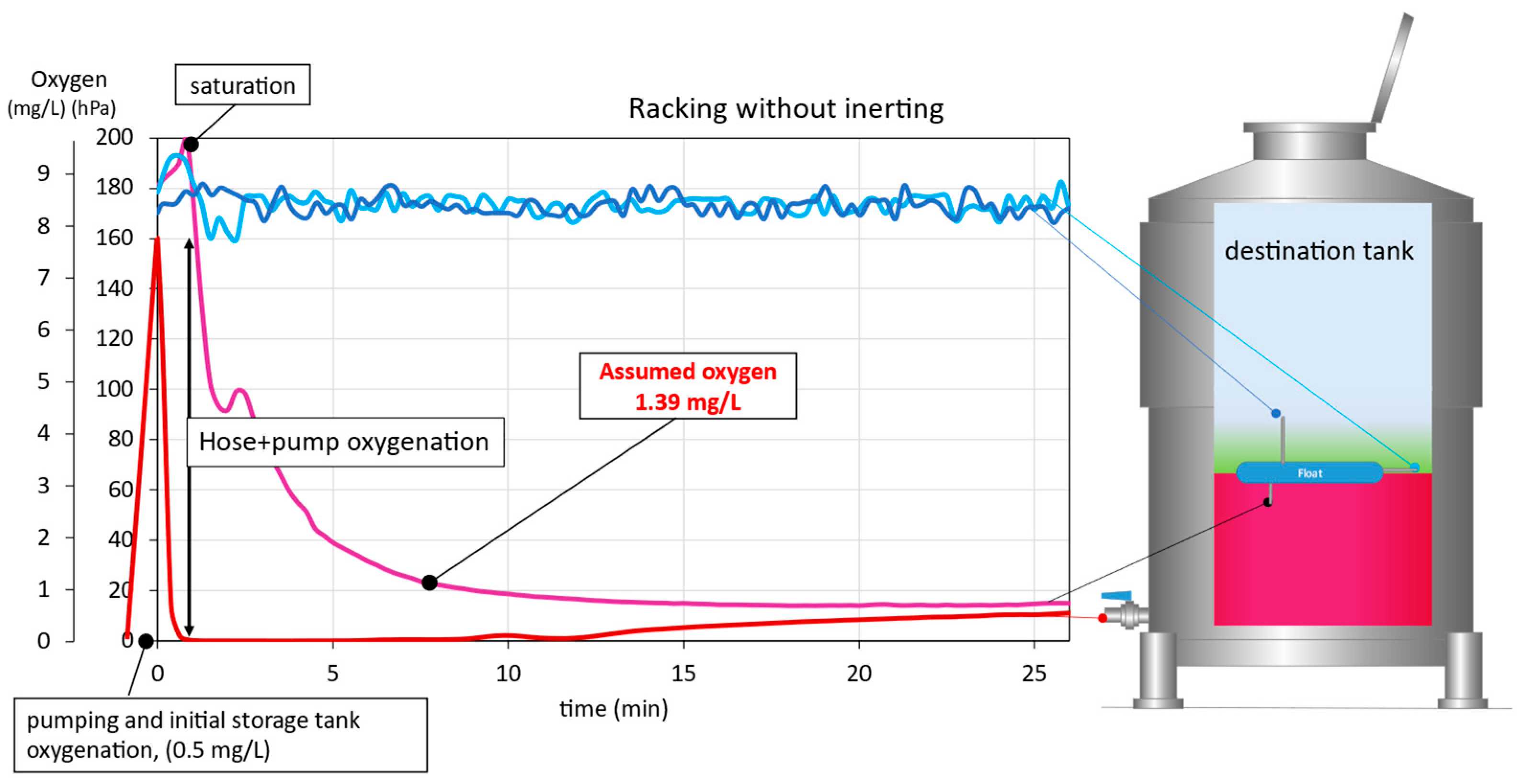

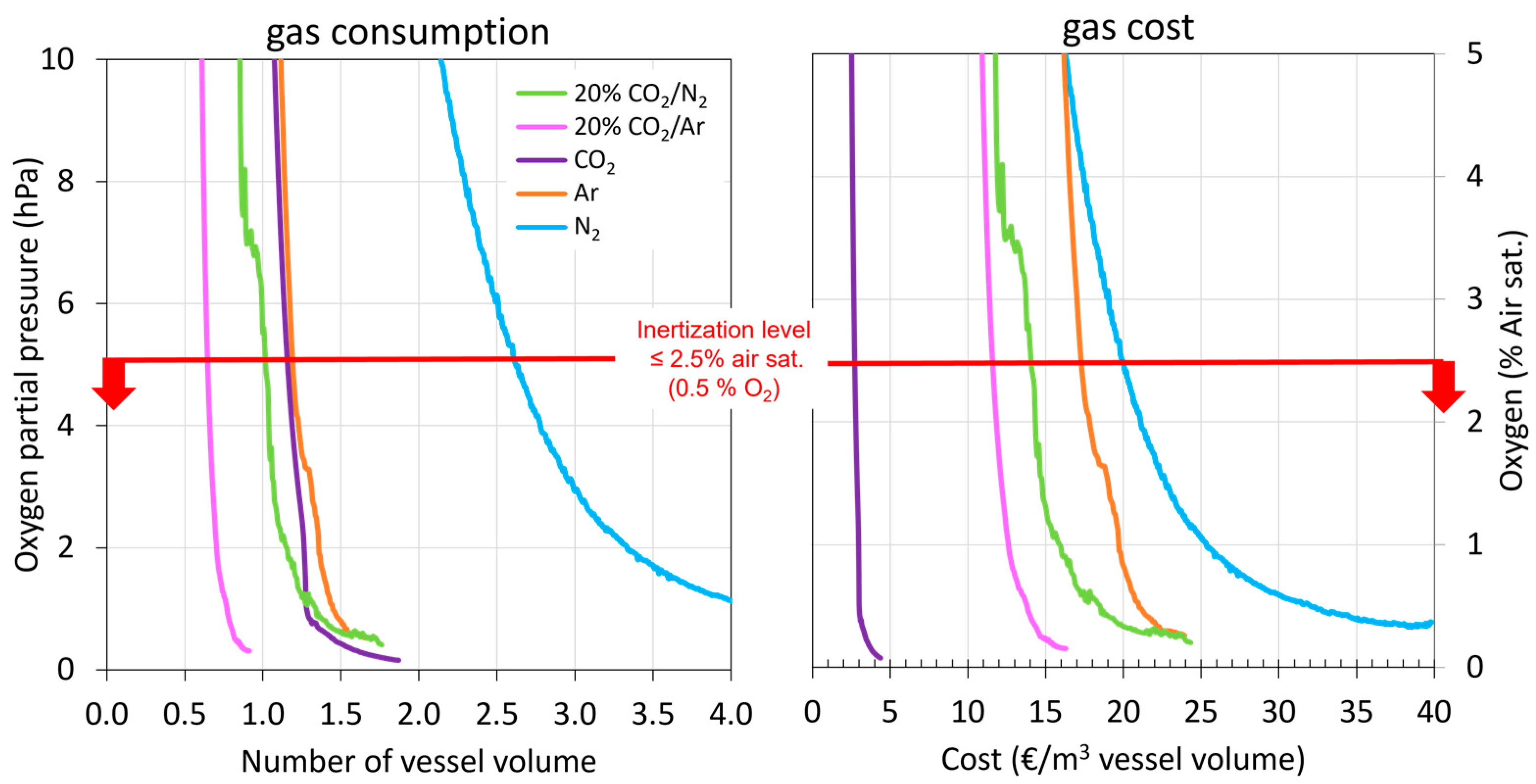
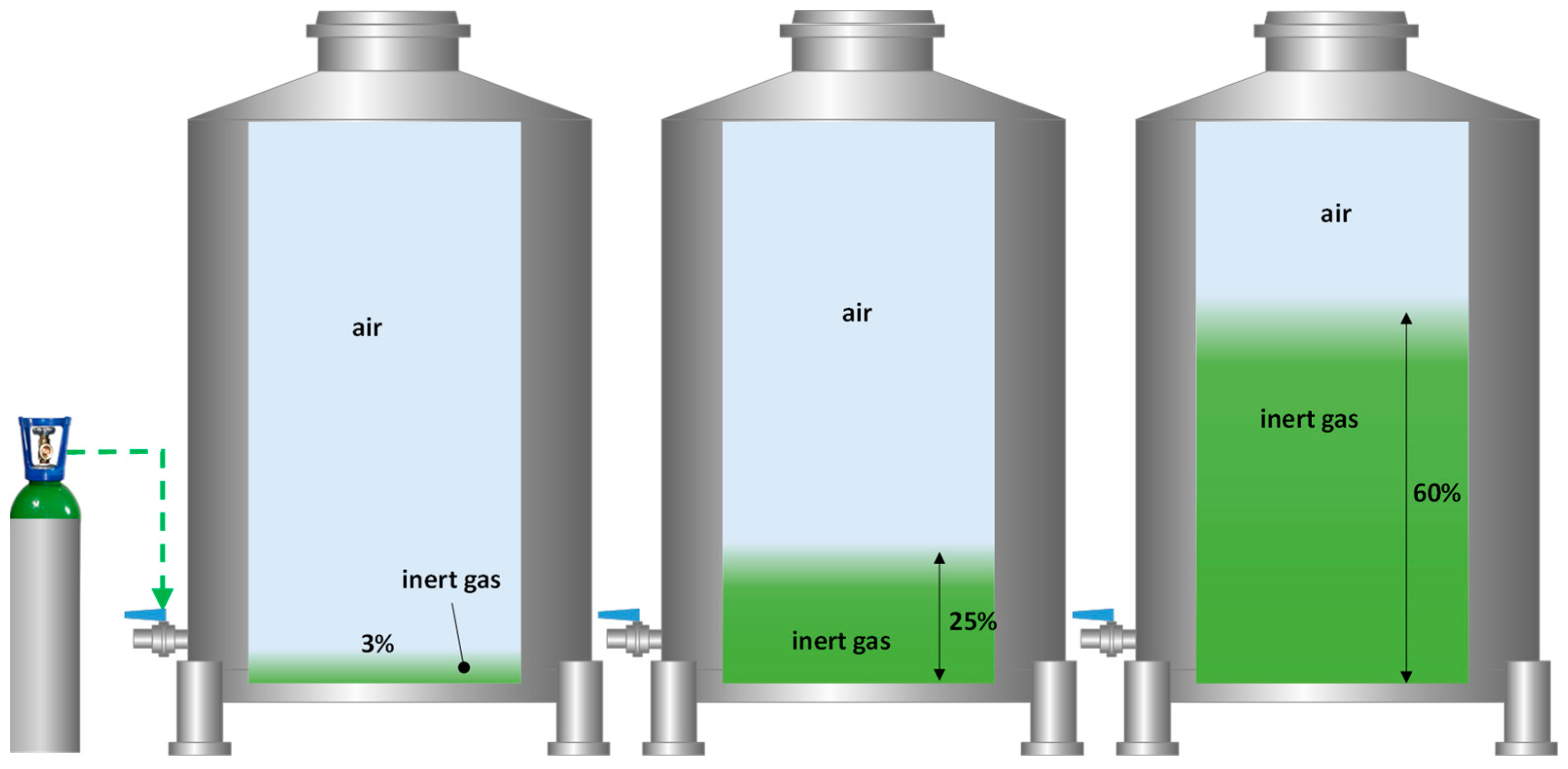
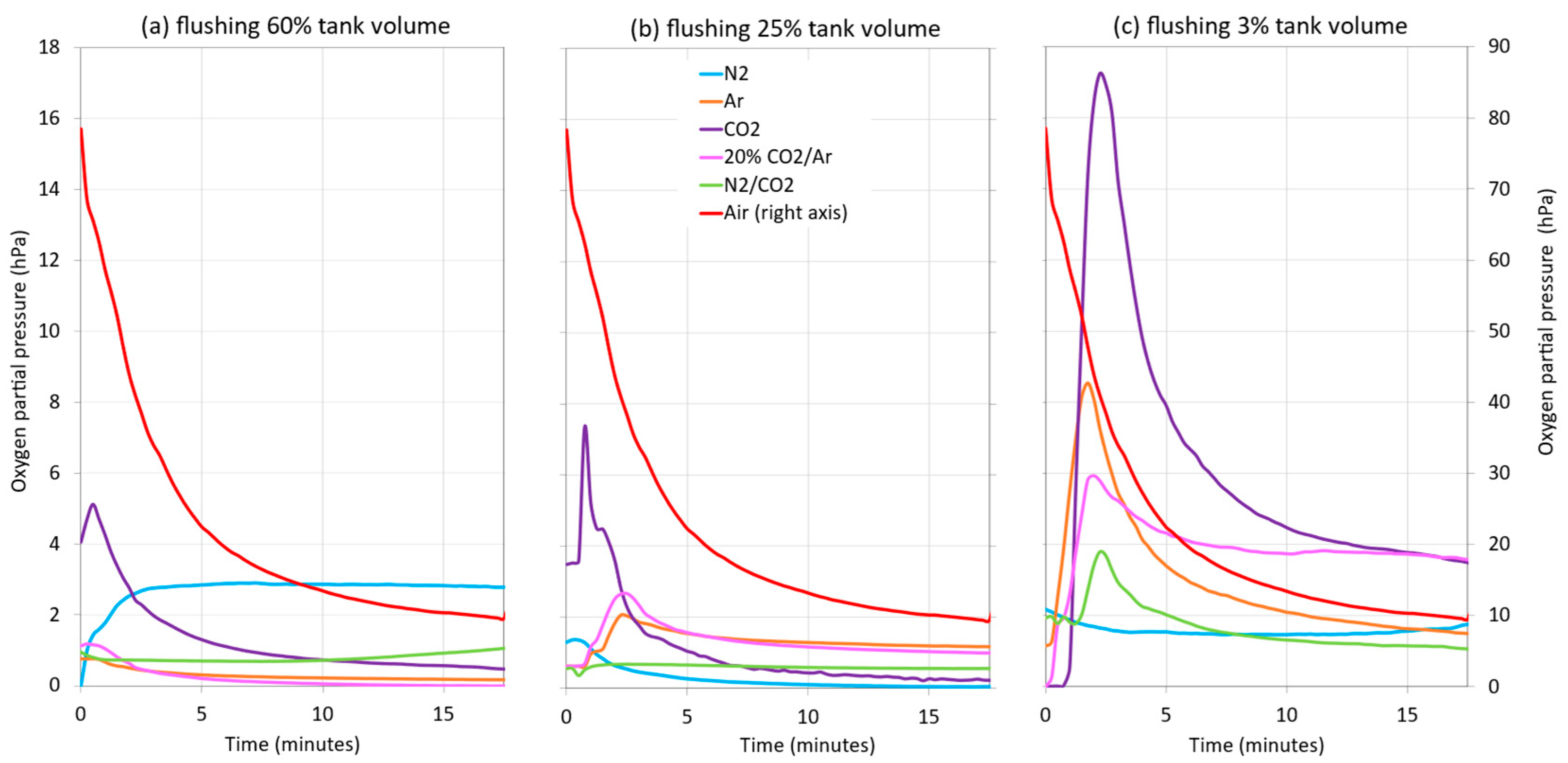
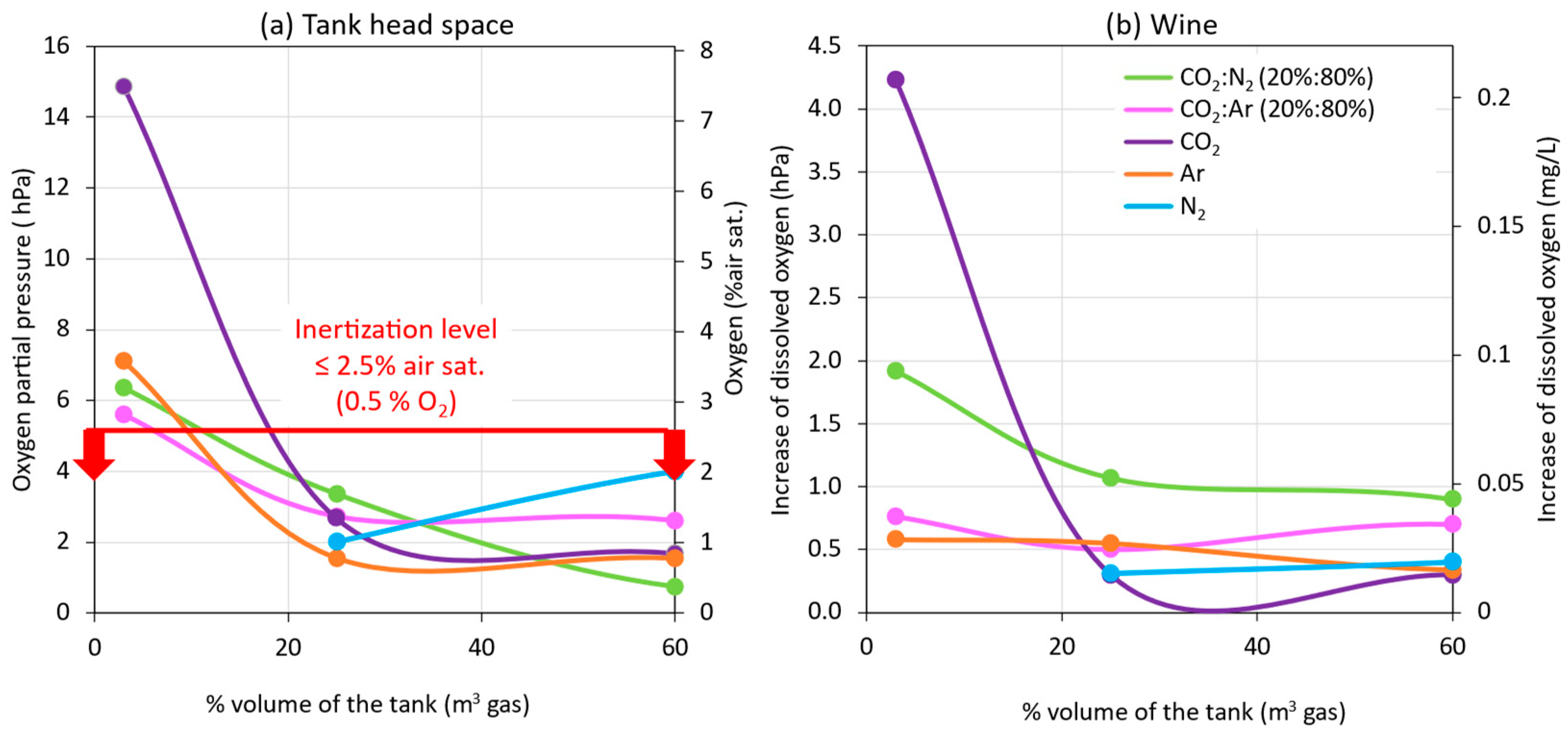


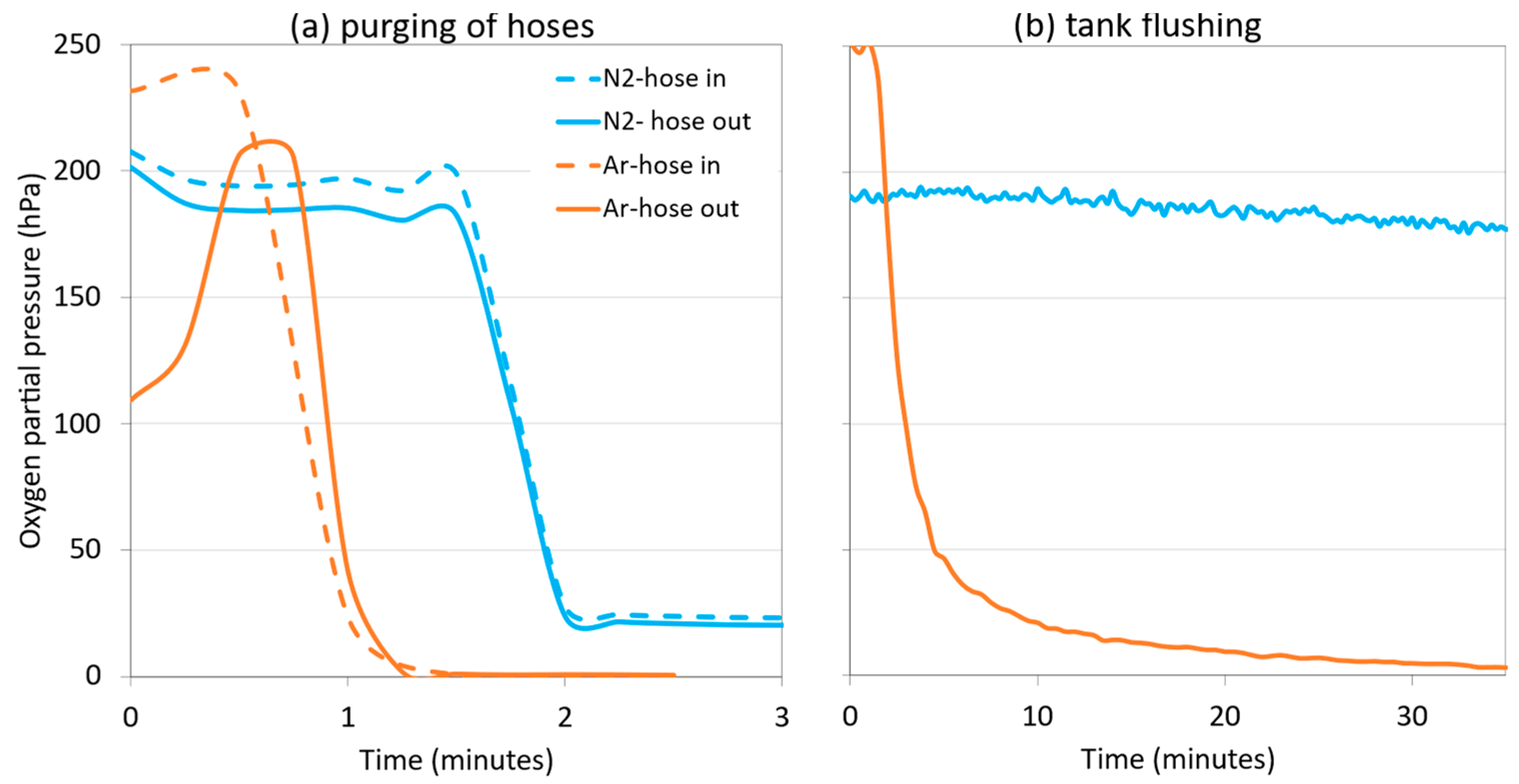

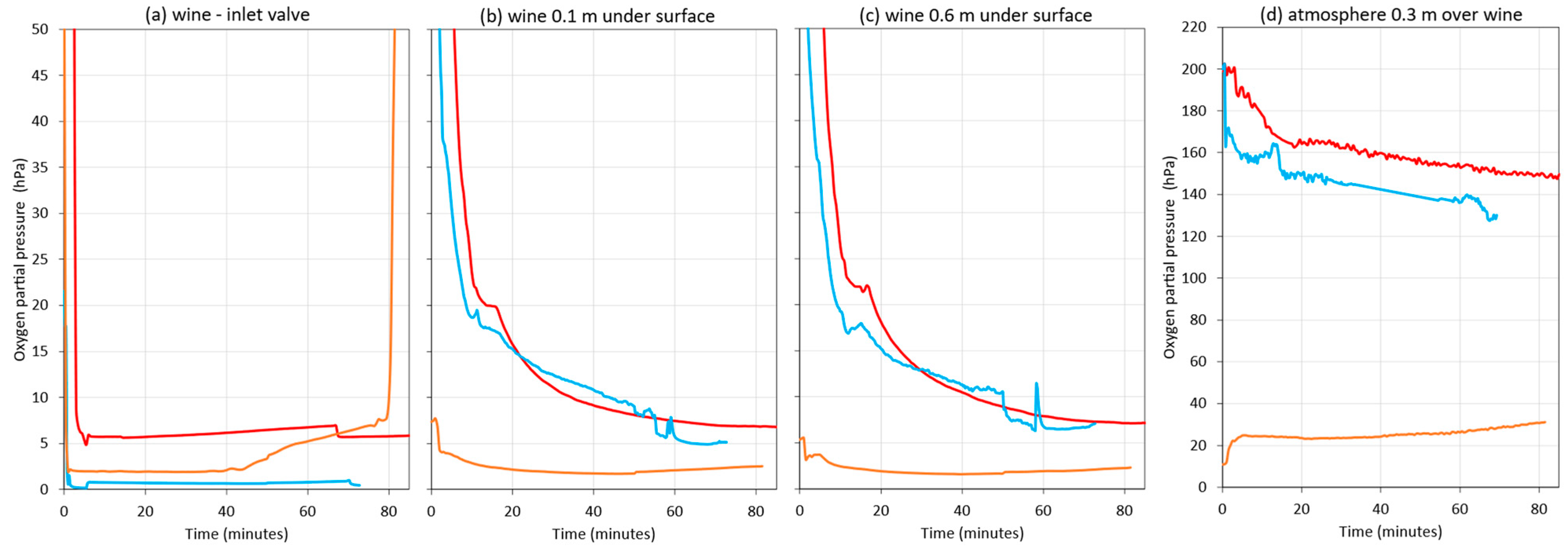
Disclaimer/Publisher’s Note: The statements, opinions and data contained in all publications are solely those of the individual author(s) and contributor(s) and not of MDPI and/or the editor(s). MDPI and/or the editor(s) disclaim responsibility for any injury to people or property resulting from any ideas, methods, instructions or products referred to in the content. |
© 2023 by the authors. Licensee MDPI, Basel, Switzerland. This article is an open access article distributed under the terms and conditions of the Creative Commons Attribution (CC BY) license (https://creativecommons.org/licenses/by/4.0/).
Share and Cite
del Barrio-Galán, R.; Nevares, I.; del Alamo-Sanza, M. Characterization and Control of Oxygen Uptake in the Blanketing and Purging of Tanks with Inert Gases in the Winery. Beverages 2023, 9, 19. https://doi.org/10.3390/beverages9010019
del Barrio-Galán R, Nevares I, del Alamo-Sanza M. Characterization and Control of Oxygen Uptake in the Blanketing and Purging of Tanks with Inert Gases in the Winery. Beverages. 2023; 9(1):19. https://doi.org/10.3390/beverages9010019
Chicago/Turabian Styledel Barrio-Galán, Rubén, Ignacio Nevares, and Maria del Alamo-Sanza. 2023. "Characterization and Control of Oxygen Uptake in the Blanketing and Purging of Tanks with Inert Gases in the Winery" Beverages 9, no. 1: 19. https://doi.org/10.3390/beverages9010019
APA Styledel Barrio-Galán, R., Nevares, I., & del Alamo-Sanza, M. (2023). Characterization and Control of Oxygen Uptake in the Blanketing and Purging of Tanks with Inert Gases in the Winery. Beverages, 9(1), 19. https://doi.org/10.3390/beverages9010019







